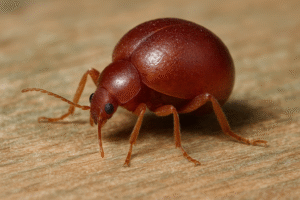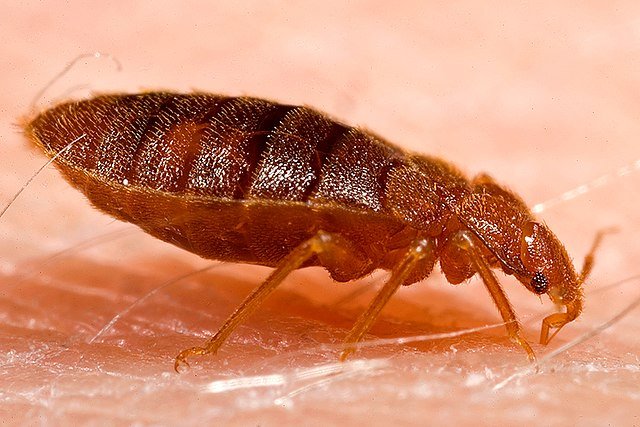Do Spider Beetles Bite? A Complete Guide for Homeowners and Small Businesses
 As a pest control expert, I often get calls about “mystery beetles” crawling in pantries, restaurants, or old storage rooms. One of the most common suspects is the spider beetle (Ptinidae family, including species like Gibbium psylloides and Mezium affine). Because of their round bodies and long legs, many people mistake them for spiders or bed bugs, and one of the first questions I hear is: “Do spider beetles bite?”
As a pest control expert, I often get calls about “mystery beetles” crawling in pantries, restaurants, or old storage rooms. One of the most common suspects is the spider beetle (Ptinidae family, including species like Gibbium psylloides and Mezium affine). Because of their round bodies and long legs, many people mistake them for spiders or bed bugs, and one of the first questions I hear is: “Do spider beetles bite?”
The short and clear answer: No, spider beetles do not bite humans or animals. They feed on stored food products and organic debris, not on blood. Still, their presence in kitchens, cafés, or warehouses can be alarming and can lead to food contamination.
In this guide, I’ll explain how to identify spider beetles, their biology, risks, and—most importantly—how to control them safely and effectively.
Identification of Spider Beetles
Spider beetles are small insects, but their unusual appearance makes them stand out.
Size: 1.5–4 mm long.
Color: Reddish-brown, black, or sometimes pale yellow. Some species look almost shiny.
Shape: Round, globular body with long legs and antennae—this is why they resemble spiders.
Wings: They have wings but rarely fly indoors.
Common species:
Gibbium psylloides (smooth spider beetle)
Mezium affine (hairy spider beetle)
Ptinus tectus (Australian spider beetle)
How they differ from bed bugs: Bed bugs are flat and blood-feeding, usually found near beds. Spider beetles are rounder and almost look like tiny spiders or ticks but are completely harmless to humans.
Biology and Ecology
Understanding their biology helps in controlling them.
Diet: Spider beetles are scavengers. They feed on grains, flour, cereals, dried fruits, wool, feathers, dead insects, and even rodent droppings.
Habitat: Dark, undisturbed, and humid places. Pantries, old cupboards, attics, and food storage areas are common.
Reproduction: Females lay eggs directly on food sources. A single female can produce dozens of eggs.
Life cycle: Egg → larva → pupa → adult. The larval stage does the most feeding damage.
Climate tolerance: They thrive in cool, damp environments but can survive in many climates.
This wide diet and adaptability make spider beetles a common nuisance in both homes and food businesses.
Global Distribution
Spider beetles are found worldwide.
North America: Regular pests in food warehouses and homes.
Europe: Common in older buildings, museums, and food shops.
Australia: Ptinus tectus (Australian spider beetle) is widespread.
Asia: Frequently reported in grain storage facilities.
Africa and South America: Present but less documented, often associated with imported food products.
No matter where you live, if conditions are right (food + moisture + darkness), spider beetles can appear.
Risks and Damage
Let’s be clear: spider beetles do not bite humans. But this does not mean they are harmless.
Health Risks
Food contamination: Infesting dry food like flour, rice, pasta, spices, or pet food.
Allergic reactions: Rarely, their shed skins or droppings can cause mild allergies in sensitive people.
Panic and confusion: Because they look like spiders or bed bugs, they often cause unnecessary fear.
Property Risks
Damage to stored food: Large infestations can spoil significant amounts of food.
Damage to organic materials: Wool, silk, feathers, or even museum specimens can be attacked.
Reputation loss: In restaurants or food shops, the sight of spider beetles can scare customers and harm business credibility.
Signs of Infestation
How do you know if spider beetles are present? Look for:
Small, spider-like beetles crawling on walls, shelves, or inside food containers.
Larvae or shed skins in food packaging.
Food products with small holes, webbing, or fine dust.
Beetles hiding in cracks, especially in old cupboards or pantries.
One key sign: infestations often appear in dark and rarely disturbed areas—for example, the back of a storage shelf or forgotten grain sacks.
Control Methods
1. Inspection and Identification
Always confirm that the insect is a spider beetle and not a bed bug or tick. Use a magnifying glass if needed.
2. Sanitation
Remove infested food products.
Vacuum cupboards, cracks, and corners.
Wash shelves with warm soapy water or vinegar solution.
3. Environmental Control
Reduce humidity with dehumidifiers or ventilation.
Store food in airtight containers.
Rotate stock in food shops to avoid old, forgotten products.
4. Physical Control
Freezing: Infested small items (flour bags, books, fabrics) can be frozen at -18°C for at least 72 hours.
Heat treatment: Heating items above 50°C kills all stages.
5. Chemical Control
Spider beetles are usually managed without chemicals. But in large facilities, professionals may apply:
Residual insecticides in cracks and voids.
Insect growth regulators (IGRs) to disrupt reproduction.
Chemicals should always be the last step, and only applied by licensed professionals.
Advanced Approaches
In larger operations (warehouses, museums, archives), more advanced methods are used:
Integrated Pest Management (IPM): Monitoring traps, sanitation, and selective chemical use.
Pheromone traps: For certain species, pheromone lures can help detect and reduce populations.
Controlled atmosphere storage: Removing oxygen or increasing CO₂ in sealed environments can eliminate infestations.
Biological control: Research is exploring natural predators of spider beetles, though not yet widely applied.
Cultural and Historical Context
Spider beetles have been known since ancient times. Old texts mention “small spider-like insects in granaries.” In European museums, infestations in natural history collections are a long-standing challenge.
The confusion with biting pests is modern. Online forums are full of people asking about “spider beetle bites,” but the myth persists only because of their spider-like shape. In reality, I have treated thousands of infestations and never once seen a spider beetle bite a person.
Frequently Asked Questions (FAQ)
1. Do spider beetles bite humans?
No. They are scavengers of stored food and debris. They cannot bite or sting.
2. Why are they called spider beetles?
Because their round bodies and long legs make them look like small spiders.
3. Where do spider beetles come from?
They usually enter with contaminated food products or migrate from nearby infested areas.
4. Can spider beetles infest my bed?
Rarely. They may wander, but they do not feed on blood or bedding. If you see them in your bedroom, they are probably just strays from a nearby pantry or storage area.
5. How do I get rid of spider beetles naturally?
Remove infested food, reduce humidity, clean thoroughly, and use airtight storage. Freezing small items also works.
6. Are spider beetles dangerous for pets?
No. They are not parasites. But they can infest pet food if it’s stored improperly.
7. How long can they live without food?
Adults can survive weeks, sometimes months, especially in cool conditions, but they need organic matter to reproduce.
Final Thoughts
After many years in pest control, I can confirm one thing: spider beetles (Ptinidae family) do not bite humans or animals. The “spider beetle bite” is a pure myth caused by their unusual spider-like appearance.
Still, that doesn’t mean you should ignore them. Spider beetles can contaminate food, damage products, and hurt the reputation of a household kitchen, café, or restaurant. The best way to manage them is not with panic or overuse of chemicals, but with practical steps: reduce humidity, store food properly, clean thoroughly, and, if needed, bring in a licensed professional.
The key message is simple: spider beetles are food pests, not bloodsuckers. By treating the environment, you remove the conditions they need to survive.
Disclaimer
This article is for informational purposes only. Pest control laws and approved chemicals vary by country. For best results and legal safety, we strongly recommend contacting a licensed pest control professional in your local area. Always make sure that the pest control technician is properly certified or licensed, depending on your country’s regulations. It’s important to confirm that they only use approved products and apply them exactly as instructed on the product label. In most places in Europe, UK, or USA, following label directions is not just best practice—it’s the law.
Author Bio
Nasos Iliopoulos
BSc Agronomist & Certified Pest Control Expert
Scientific Director – Advance Services (Athens, Greece)
Licensed Pest Control Business – Ministry of Rural Development & Food (GR)
References
Penn University - Spider Beetles

